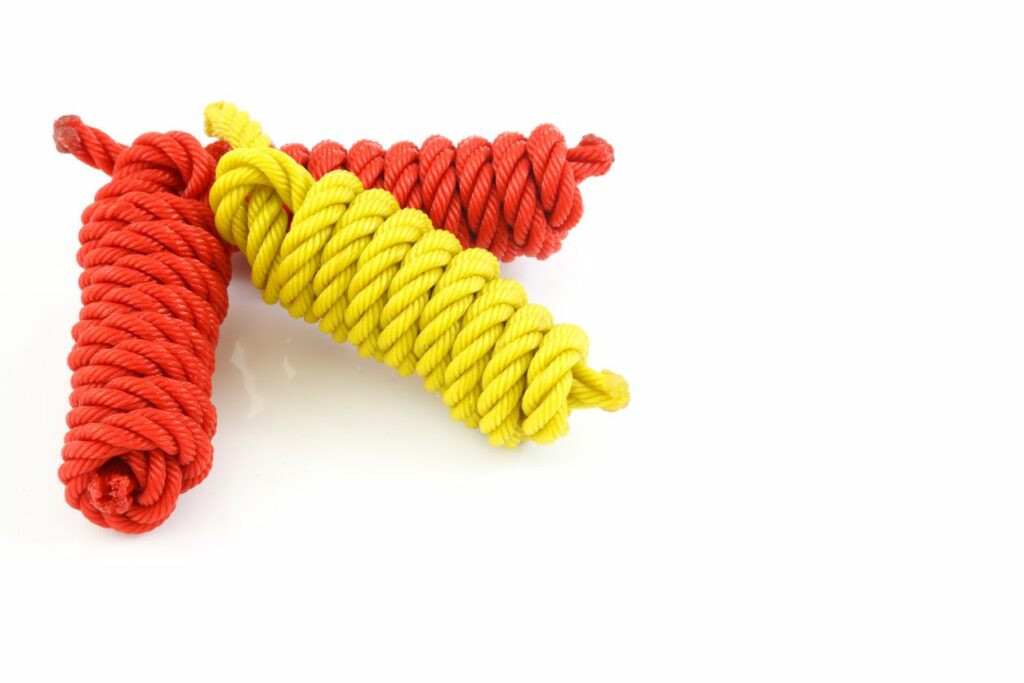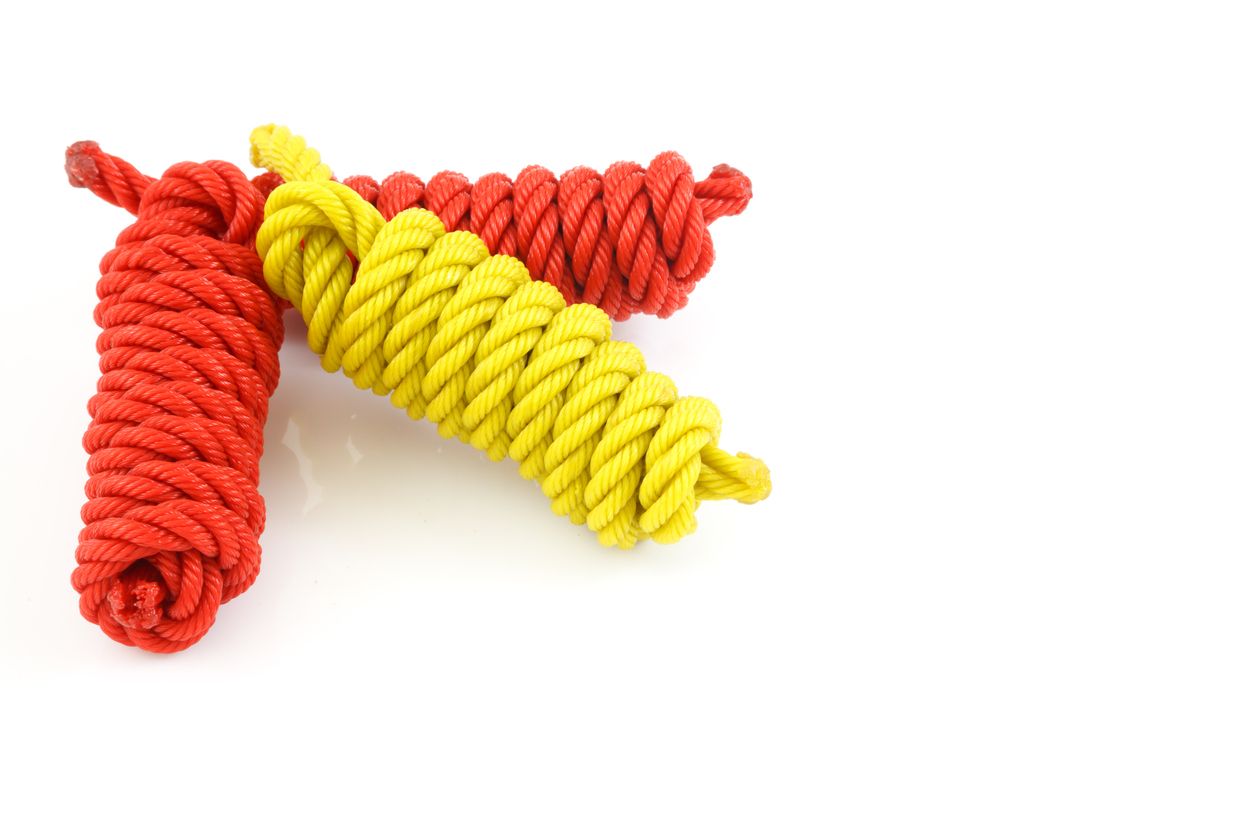Nylon Rope is the strongest rope in common use. Nylon is a thermoplastic that is melted and formed into rope-like fibers. It is stronger than other natural and synthetic ropes and is perfect for a wide variety of purposes.
Nylon was invented for the women’s hosiery industry. It became a popular item marketed for its durability, claiming it would never run like silk. As America began fighting in World War 2, nylon began having military uses. Nylon was so vital to the war effort that it helped the Allies win. After the war, nylon manufacturers again focused on the creation of apparel. Today, nylon is widespread and can be found in many different items.

The creation of nylon drastically changed the rock-climbing industry as well. Before nylon’s invention, climbers used natural ropes prone to wear and breaking. Natural ropes are dangerous for climbing. So, nylon ropes have made the hobby significantly safer.
The versatile nature of nylon rope makes it suitable for use across many industries. There are six common uses of nylon rope:
- Rodeos & farm use
- Rock climbing & mountaineering
- Boating & marine applications
- Military & outdoor uses
- Industrial uses
- Medical uses
Every type of rope has its advantages and disadvantages. It’s important to compare nylon rope to other ropes. I have created a few charts detailing nylon rope’s strength and durability. See how the weaving patterns and diameter affect the strength of your nylon rope. Also, see which synthetic rope type is right for your intended use.
What Is Nylon Rope?
Nylon is a type of thermoplastic that has silk-like characteristics. It is a synthetic polymer comprising polyamides. Nylon is generally made from petroleum. It can be melted and processed into rope fibers and various other shapes.
Nylon rope is widely known for its superior strength. It also has the ability to absorb tremendous shock loads. Nylon rope is elastic. It can quickly return to its original shape and length after handling heavy loads. These ropes are resistant to rot, chemicals, oil, abrasion, and UV rays.
The History Of Nylon Rope
Researchers at DuPont began experimenting with cellulose-based fibers. They created the world’s first synthetic fiber: rayon. The researchers began studying polymers in 1927. It wasn’t until 11 years later, in 1938, that they unveiled their creation of nylon.
Nylon Stockings
Nylon 66 was the first synthetic thermoplastic polymer and the first kind of nylon made. Its creation occurred on February 28, 1935. The inventor was researcher Wallace Hume Carothers of the DuPont Experimental Station. On January 29, 1938, researcher Paul Schlack of IG Farben created nylon 6.
The first products made with nylon were women’s stockings that began selling on October 24, 1939. Nylon stockings were huge hits the first year they came out. Manufacturers produced 1,300 tons of nylon fabric and sold 64 million pairs of stockings.
Military Use
In 1941, nylon made its way into the military and helped the Allies win World War 2. Nylon is strong, lightweight, elastic, and resistant to mildew. All these qualities proved helpful in the military.
DuPont shifted its nylon production from women’s hosiery to military production. Nylon acted as a replacement for Japanese silk. Military experts created parachutes and tire cords with nylon. As time passed, the military began to use nylon for even more equipment:
- Glider tow ropes
- Flak jackets
- Shoelaces
- Aircraft fuel tanks
- Hammocks
- Mosquito netting
Apparel manufacturing
After the war ended, DuPont switched back to commercial production. Their focus was once again on stockings. Consumers flocked to the stores, causing “nylon riots.” The riots occurred because women were competing for limited numbers of stockings.
By the 1950s, manufacturers began making more clothing items out of nylon. It was marketed as cheap, colorful, easy-to-wash, and disposable.
By the 1960s, the use of nylon for clothing dropped drastically. Consumers began to realize its negative environmental impacts.
Consumers once again turned to natural fibers. In 1965, 63% of the world’s textiles comprised synthetic fibers. By the 1970s, that number dropped to 45%. Nylon regained some traction in the 1990s, but it’s never been as popular as in the 50s and 60s.
Still, we see nylon in everything today. Every year, manufacturers produce about 8 million pounds of nylon. Nylon production comprises about 12% of the world’s synthetic fiber production.
The Creation Of Climbing Ropes
Climbers began using nylon ropes to climb rocks and mountains around the same time as World War 2.
Climbers were using ropes long before the invention of professional climbing gear. Before nylon, climbers used ropes made of natural fibers.
Natural fiber ropes are weak and susceptible to the elements. They aren’t elastic, so they didn’t hold a climber’s weight well. Plus, they would often twist, making climbing situations dangerous. Today, climbers know natural fiber ropes are not generally suitable for climbing.
Nylon ropes proved safer for climbing. They are stronger and more elastic, offering better fall protection.
Plus, weaving machines were invented around the same time as the invention of nylon. Instead of weaving the ropes by hand, nylon rope could be threaded with machines. The machines offered more consistent weaving patterns that resulted in stronger ropes.
Kernmantle Ropes
In 1953, the German company Edelrid invented the kernmantle rope design. The kernmantle design consisted of a strong synthetic rope core. Around the core, they placed a braided nylon sheath.
Such a design produced stronger ropes with more elasticity. The new ropes did not wear down as quickly. So, climbers had fewer issues with their ropes twisting mid-climb. Climbers cannot avoid abrasion while rock climbing. The kernmantle design offers more protection. The outer sheath took abuse from the rocks while the inner core was protected.
The kernmantle rope became the industry standard for rock climbing and mountaineering. Then, in 1964, Edelrid and Mammut developed an even better rope. Their new rope was capable of handling multiple falls. It was the precursor for today’s modern climbing ropes.
How Strong Is Nylon Rope?
Nylon is the strongest rope in common use. It is stronger than any other synthetic and natural fiber ropes.
Your rope’s strength depends on the thickness, the weaving pattern, and how much you are working the rope. The more you use your rope, putting wear-and-tear on it, the more strength it will lose.
Tensile Strength VS Working Load
You need to consider the tensile strength and the working load to determine strength.
Tensile strength refers to the total weight a rope can hold before breaking. The tensile strength is measured in a factory under controlled laboratory conditions. It does not accurately portray the amount of weight your rope can actually hold. When used in the field, your rope can hold much less weight.
The working load describes the maximum weight your rope can actually hold. It accounts for outside forces like weather and abrasion, which weaken your rope.
Experts recommend working well below your rope’s maximum working load. The working load is an average, so your rope may hold more or less weight than anticipated. You should contact the rope manufacturer for the most accurate working load limit.
Nylon Rope Strength Chart
Consult this chart to compare the tensile strength of twisted, solid, and double-braided nylon:
| Diameter | Twisted | Solid Braid | Double Braid |
| 4 mm | — | 575 lbs | — |
| 5 mm | — | 825 lbs | — |
| 6 mm | 1,650 lbs | 1,325 lbs | 1,700 lbs |
| 8 mm | — | 1,925 lbs | — |
| 9 mm | — | 2,800 lbs | — |
| 10 mm | 3,700 lbs | — | 4,100 lbs |
| 12 mm | — | 4,200 lbs | — |
| 16 mm | 10,400 lbs | — | 14,600 lbs |
| 19 mm | 13,800 lbs | — | 19,000 lbs |
| 22 mm | 20,000 lbs | — | 28,100 lbs |
| 25 mm | 25,000 lbs | — | 33,200 lbs |
| 32 mm | 37,500 lbs | — | 52,000 lbs |
| 38 mm | 53,000 lbs | — | 74,000 lbs |
| 51 mm | 90,000 lbs | — | 129,700 lbs |
| 64 mm | 125,000 lbs | — | 196,000 lbs |
| 76 mm | 195,000 lbs | — | 274,000 lbs |
| 92 mm | — | — | 400,000 lbs |
| 106 mm | — | — | — |
Consult this chart to compare the working load limit of twisted, solid, and double-braided nylon:
| Diameter | Twisted | Solid Braid | Double Braid |
| 4 mm | — | 115 lbs | — |
| 5 mm | — | 165 lbs | — |
| 6 mm | 330 lbs | 265 lbs | 340 lbs |
| 8 mm | — | 385 lbs | — |
| 9 mm | — | 560 lbs | — |
| 10 mm | 740 lbs | — | 820 lbs |
| 12 mm | — | 840 lbs | — |
| 16 mm | 2,080 lbs | — | 2,920 lbs |
| 19 mm | 2,760 lbs | — | 3,800 lbs |
| 22 mm | 4,000 lbs | — | 5,620 lbs |
| 25 mm | 5,000 lbs | — | 6,640 lbs |
| 32 mm | 7,500 lbs | — | 10,400 lbs |
| 38 mm | 10,600 lbs | — | 14,800 lbs |
| 51 mm | 18,000 lbs | — | 25,940 lbs |
| 64 mm | 25,000 lbs | — | 39,200 lbs |
| 76 mm | 39,000 lbs | — | 54,800 lbs |
| 92 mm | — | — | 80,000 lbs |
| 106 mm | — | — | — |
The Uses Of Nylon Ropes
Nylon rope is the strongest rope for common use, so it has incredible versatility.
There are six common uses of nylon rope:
- Rodeos & farm use
- Rock climbing & mountaineering
- Boating & marine applications
- Military & outdoor enthusiast use
- Industrial uses
- Medical uses
Rodeos & Farm Use
Nylon ropes work well for animal leads and are popular on farms. Farmhands, cowboys, ranchers, etc., use nylon ropes are lariat ropes. Lariat ropes are restraints that you throw around a target. Then, you pull the rope tight to hold the item or animal in place. Spanish and Mexican cowboys first used lariat ropes. Eventually, lariat ropes also came to the United States.
Famers also tend to use nylon rope to tie down crops that have trouble staying upright.
Rodeo & Farm Use of Nylon Rope:
- Animal leads
- Lariat ropes
- Tie-downs
Rock Climbing & Mountaineering
Nylon ropes are strong, durable, and water-resistant. These properties make nylon the best material for rock climbers and mountaineers.
Rockling & Mountaineering Uses Of Nylon rope:
- Crampons
- Carabiners
- Lanyards
- Safety Harnesses
Boating & Marine Applications
Nylon rope is rot and water-resistant. These qualities make it perfect for use in marine applications. Nylon is one of the main kinds of ropes that sailors and boaters use on their vessels. Nylon mono-filament is the main product used for fishing lines. The docking and anchor lines used for boats also consist of nylon rope.
Boating & Marine Uses Of Nylon Rope:
- Mooring
- Towing
- Surge lines
- Boat falls
- Safety lines
- Target tow ropes
- Fishing ropes
- Tie-downs
- Webbing repair
Military & Outdoor Enthusiast Uses
Just years after its invention, nylon became commonly used in the military. It even helped the Allies win World War 2. Paracord is a type of nylon rope that we use to suspend parachutes. Survivalists and outdoor adventurers also create braided and knotted items from paracord.
Hikers and backpackers like nylon because of its rot-resistance and durability. It is the ideal material for creating hiking tools like harnesses.
Military & Outdoor Enthusiast Uses Of Nylon Rope:
- Parachutes
- Paracord jewelry & items
- Hiking gear
Industrial Uses
Nylon rope is popular in industrial applications because of its durability and strength. Workers use nylon rope in construction, creating bridges and other large structures.
Industrial Uses Of Nylon Rope:
- Industrial slings
- Construction
- Bridges
Medical Uses
Even medical practitioners use nylon threads in their work. Thin nylon ropes can be used to create artificial ligaments.
Advantages & Disadvantages Of Nylon Rope
Easily consider the pros and cons of using nylon rope by consulting this chart:
| PROS | CONS |
| Superior strength | Absorbs water/shrink when wet |
| Elasticity | Weakened by water |
| UV resistant | Creates pollution |
| Chemical resistant | Releases chemicals when exposed to too much heat |
| Oil resistant | May irritate sensitive skin |
| Mold & mildew resistant | |
| Tolerant of high temperatures | |
| Supreme shock absorption | |
| Wide range of applications | |
| Low toxicity |
How Does Polypropylene Rope Compare To Other Synthetic Ropes?
Consult this chart to compare the qualities of nylon rope to other synthetic ropes:
| Polyamide (Nylon) | Polyester | Polyethylene | Polypropylene | |
| Abrasion Resistance | Great | Great | Fair | Fair |
| Acid Resistance | Good | Great | Great | Great |
| Alkali Resistance | Great | Great | Great | Great |
| Buoyancy | Sinks | Sinks | Slightly Floats | Floats |
| Durability | Great | Great | Fair | Good |
| Handling | Great | Great | Good | Good |
| Strength | Great | Good | Good | Fair |
| Melting Point | About 250°C (484°F) | About 245°C (473°F) | About 128°C (262°F) | About 150°C (302°F) |
| Rot & Mildew Resistance | Great | Great | Great | Great |
| Shock Loading | Great | Fair | Poor | Good |
| Storage | Wet or Dry | Wet or Dry | Wet or Dry | Wet or Dry |
| U.V. Resistance | Fair | Great | Fair | Poor |
FAQs
What Is Rope Made Of?
A rope consists of either natural or synthetic fibers. Thinner threads or fibers are woven together to create thicker strands called “rope.” Natural ropes generally comprise hemp, cotton, sisal, jute, and manila. Synthetic materials often comprise nylon, polyester, polypropylene, or polyethylene.
Is Nylon Rope Recyclable?
Nylon is recyclable, but there may not be a recycling center near you that accepts it. Most recycling centers accept nylon, but not all.
Nylon is a synthetic material that does not break down. It’s recommended to repurpose your old rope or have it recycled to help preserve the environment. Nylon rope is usually recycled with other similar plastics.
Is Nylon Rope Safe For Pets?
Most veterinarians recommend against using any kind of rope with your pets. Natural fiber ropes are safer since they break down, but even they can cause problems. Pets that swallow long rope threads suffer life-threatening digestive complications. It can be challenging for veterinarians to operate on a pet that consumed rope. The rope acts like a cinch in the intestines. Rope is dangerous for dogs, cats, and birds.
Does Nylon Rope Float?
Nylon rope cannot float. Nylon is useful in wet conditions because it resists rot and mildew but loses up to 25% of its strength when wet. For a rope that floats, choose polypropylene which is also resistant to rot and mildew.





